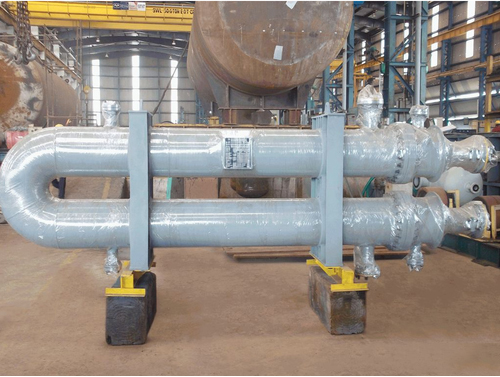In the realm of thermal management and industrial processes, simplicity and efficiency often go hand in hand. One such example is the double pipe heat exchanger, a deceptively straightforward yet highly effective device that has stood the test of time. These unassuming workhorses harness the power of concentric tube configurations, facilitating efficient heat transfer between two fluids while offering a host of advantages. This article delves into the world of double pipe heat exchangers, exploring their design, operating principles, and the numerous benefits that have made them indispensable across various industries.
The Simple yet Ingenious Design:
At the heart of a double pipe heat exchanger lies a remarkably simple yet ingenious design. It consists of two concentric pipes, with one pipe nested inside the other. This configuration creates two separate flow paths, allowing two different fluids to flow in opposite directions while facilitating heat transfer through the shared wall separating them.
The inner pipe, often referred to as the tube, carries one fluid stream, while the outer pipe, or shell, accommodates the second fluid. This counter-current flow arrangement ensures optimal heat exchange, as the hottest portion of one fluid stream encounters the coldest portion of the other, maximizing the temperature differential and heat transfer efficiency.
Unparalleled Simplicity and Robustness:
One of the defining characteristics of double pipe heat exchangers is their unparalleled simplicity and robustness. Unlike more complex designs with intricate internal components, these devices boast a streamlined construction, reducing the risk of potential failure points and minimizing maintenance requirements.
The absence of baffles, tube sheets, or intricate flow patterns translates into enhanced durability and resistance to fouling or scaling, ensuring reliable performance over an extended operational lifespan. This simplicity also facilitates easy cleaning and maintenance procedures, further contributing to cost-effectiveness and reduced downtime.
Versatility and Adaptability:
Despite their simplistic design, double pipe heat exchangers are remarkably versatile and adaptable. They can accommodate a wide range of fluid types, including liquids, gases, and even two-phase mixtures, making them invaluable across various industries, such as chemical processing, food and beverage production, HVAC systems, and power generation.
Moreover, double pipe heat exchangers can be engineered to withstand extreme temperatures, pressures, and corrosive environments, ensuring reliable performance even in the most demanding applications. This adaptability has made them a preferred choice for countless industrial processes and thermal management solutions.
Compact and Space-Efficient Design:
In today’s industrial landscape, where space is often at a premium, the compact and space-efficient design of double pipe heat exchangers offers a significant advantage. By leveraging the concentric tube configuration, these devices can achieve high heat transfer surface area-to-volume ratios, enabling exceptional thermal performance while minimizing the overall footprint.
This space-saving feature not only reduces installation costs but also facilitates easier integration into existing facilities or space-constrained environments. Additionally, the lightweight nature of double pipe heat exchangers contributes to their portability and ease of transportation, making them a versatile choice for various applications.
Low Maintenance and Cost-Effective Operation:
Double pipe heat exchangers are renowned for their low maintenance requirements and cost-effective operation. Their streamlined design and lack of intricate internal components minimize the risk of fouling, scaling, or buildup, reducing the need for frequent cleaning and maintenance interventions.
Furthermore, the absence of complex auxiliary components, such as pumps or secondary cooling loops, simplifies the overall system design and operation, contributing to lower operational costs. This low-maintenance aspect translates into reduced downtime, extended service life, and significant cost savings over the lifetime of the heat exchanger.
Diverse Applications:
The versatility of double pipe heat exchangers extends far beyond their simple design. These devices find applications in a wide range of industries, each with its unique set of requirements and challenges.
In the chemical and petrochemical sectors, double pipe heat exchangers facilitate efficient heat transfer during distillation, separation, and reaction processes, handling a diverse range of fluids and operating conditions. The food and beverage industry relies on these heat exchangers for precise temperature control during pasteurization, sterilization, and other thermal processes, ensuring product quality and safety.
Furthermore, double pipe heat exchangers play a vital role in HVAC systems, contributing to efficient heat transfer for heating and cooling applications in commercial and residential buildings. The power generation industry also benefits from their compact design and ability to withstand extreme environments, making them essential components in condensers, feedwater heaters, and other critical systems.
Conclusion:
Double pipe heat exchangers have solidified their position as indispensable components in the realm of thermal management and heat transfer solutions. Their simple yet ingenious design, combining concentric tube configurations with unparalleled robustness and adaptability, offers uncompromising performance and reliability. As industries continue to prioritize energy efficiency, sustainability, and compact design solutions, the demand for double pipe heat exchangers is poised to grow. Their ability to accommodate diverse fluid streams, withstand harsh operating conditions, and achieve efficient heat transfer while minimizing footprint and maintenance requirements make them an attractive choice across various sectors. Whether in chemical processing plants, food and beverage production facilities, HVAC systems, or power generation installations, double pipe heat exchangers stand as a testament to engineering excellence, combining time-tested principles with robust construction to deliver reliable and cost-effective thermal management solutions. As the world continues its pursuit of sustainable and efficient thermal management solutions, these remarkable devices will undoubtedly play a pivotal role in shaping a more energy-conscious and environmentally responsible future for industries worldwide.
